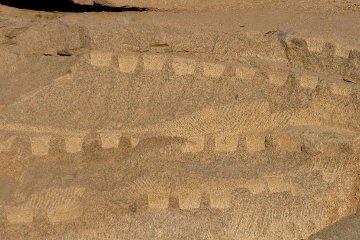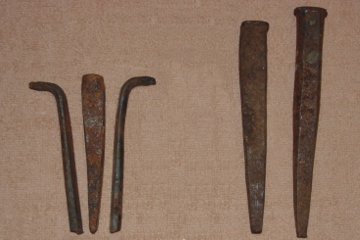Plug and Feathers
| Aswan Quarry | 24 04 36.93N 32 53 43.55E | The Unfinished Obelisk can be clearly seen. Lines of slots can be seen in the rock faces north of the obelisk. |
As usual when the Digging Up the Past Tour visits the granite quarries at Aswan, I marvelled at the way in which the ancient Egyptians carved up the mountains as if they were cutting cheese. Granite is one of the hardest rocks known to man, yet these amazing craftsmen, armed with nothing harder than bronze tools, cut out great blocks of stone and fashioned them into fine buildings, towering obelisks and intricate statues.
On my return to Britain I decided to see if I could discover more about how they might have done all this, and the obvious place to start was with someone whose trade is stone. I went along to the Vale of Clwyd Memorials and spoke to the owner/manager, Mr Richard Morris. The first question I asked was how quarrymen hacked out the initial blocks of stone.

| |
| These marks indicate the lines along which the ancient quarry men split the rock. |
All around the quarries at Aswan are evidences that the first step was to cut a series of slots into the stone. These slots were between four and five inches long, an inch or inch and a half wide, and about two inches deep. There was about an inch between slots. The traditional explanation is that, having cut the slots the Egyptian workmen then hammered wood into them and poured water onto the wood. As the wood absorbed the water it swelled and the force thus exerted split the rock.
I must admit to having always been a bit sceptical about this explanation, but I do know that natural processes can exert tremendous force and I just assumed that the "experts" knew what they were talking about. It seems, however, that they didn't! Just recently someone in a spirit of investigation tried the technique, but no matter how much water they poured onto the wooden wedges, the granite remained stubbornly unsplit.
An alternative use for the slots was urgently needed and the investigator suggested that a line of Egyptians armed with crowbars might have provided the necessary force. The obvious difficulty with this suggestion is how you could cram so many Egyptians into such a small space: you would need one man with a crowbar every five or six inches! I put the idea to Mr Morris and he pointed out another problem: how could you synchronise all the crowbars to provide an even force along the whole line of the slots?
"It reminds me," he said, "of the technique my father used when he wanted to split rock."

| |
| The two L-shaped objects on the left are the feathers, which are driven apart by the plugs. |
Today Vale of Clwyd Memorials is equipped with all the latest machinery for cutting, drilling and polishing the stones with which they deal, but forty or more years ago many of these machines had not even been invented. When Mr Morris' father wanted to split a lump of rock in two he first drilled a series of holes along the line of the projected split and then used the "plug and feather" technique. The metal "feathers" were put in place on each side of the hole and the plug, a long, thin wedge, was hammered down between them. When all the wedges were firmly in place, splitting the rock was simply a matter of tapping each wedge in turn, driving it further in between the feathers and increasing the tension until the cumulative pressure cracked the rock in half.
Of course there still remained the problem of why the Egyptians cut slots instead of simply drilling holes, and also how they could use the "plug and feather" technique in such shallow slots. On the whole, however, this explanation carries more conviction - to me at least - than either of the previous suggestions.

| |
| Circular drills cut these cores: on the right is a practice piece, on the left a core cut out of basalt, a very hard rock. |
We then turned to the problem of how the Egyptians could bore holes in such a hard material as granite. Sir Flinders Petrie discovered vases of granite, basalt and obsidian which had been hollowed out by some form of tubular saw or drill which cut a deep, circular groove in the vase, leaving a cylindrical core which was then broken out. Today, of course, you would use some form of hardened steel or even a diamond-coated saw, but the Egyptians had neither. I put this to Mr Morris.
"I presume," he replied, "that time was not a problem and also that they had plenty of sand."
I confirmed that both these suppositions were correct. Labour was cheap, whether slave or free, and the deserts that border the Nile have no lack of sand.
Mr Morris then went on to explain that "sharp" sand could provide nearly as effective a cutting instrument as diamond and that bronze or even wooden tools, used in association with the sand, could easily cut through the hardest granite - so long as you didn't mind the length of time the process would take.
"But surely," I objected, "the sand would wear away the wood or bronze long before it wore away the rock you were trying to cut."
Mr Morris explained that this was certainly so if the wood or bronze slid freely over a thick bed of sand. In actual fact you would only use a small amount of sand in the hole or slot. Grains of the sand would become embedded in the soft material of the tool and provide the cutting edge. As the sand became blunt and smooth you would have to replace it by fresh sand and no doubt there would be a certain amount of wear and tear on the tool, but not nearly as much as in the rock.
He then showed me a diamond-coated drill bit, which consisted of thousands of tiny diamonds or diamond chips embedded in a soft metal. As the drill bit spun, the diamonds gradually became polished and useless, but the pressure on the bit ensured that the metal holding the diamonds also wore away, allowing the worn diamonds to drop out and the new ones to be exposed.
I am deeply grateful to Mr Richard Morris for his clear explanations. Ivory-tower theoreticians might puzzle for years over these problems without ever reaching the solution which a craftsman has been happily employing for years if not generations.





